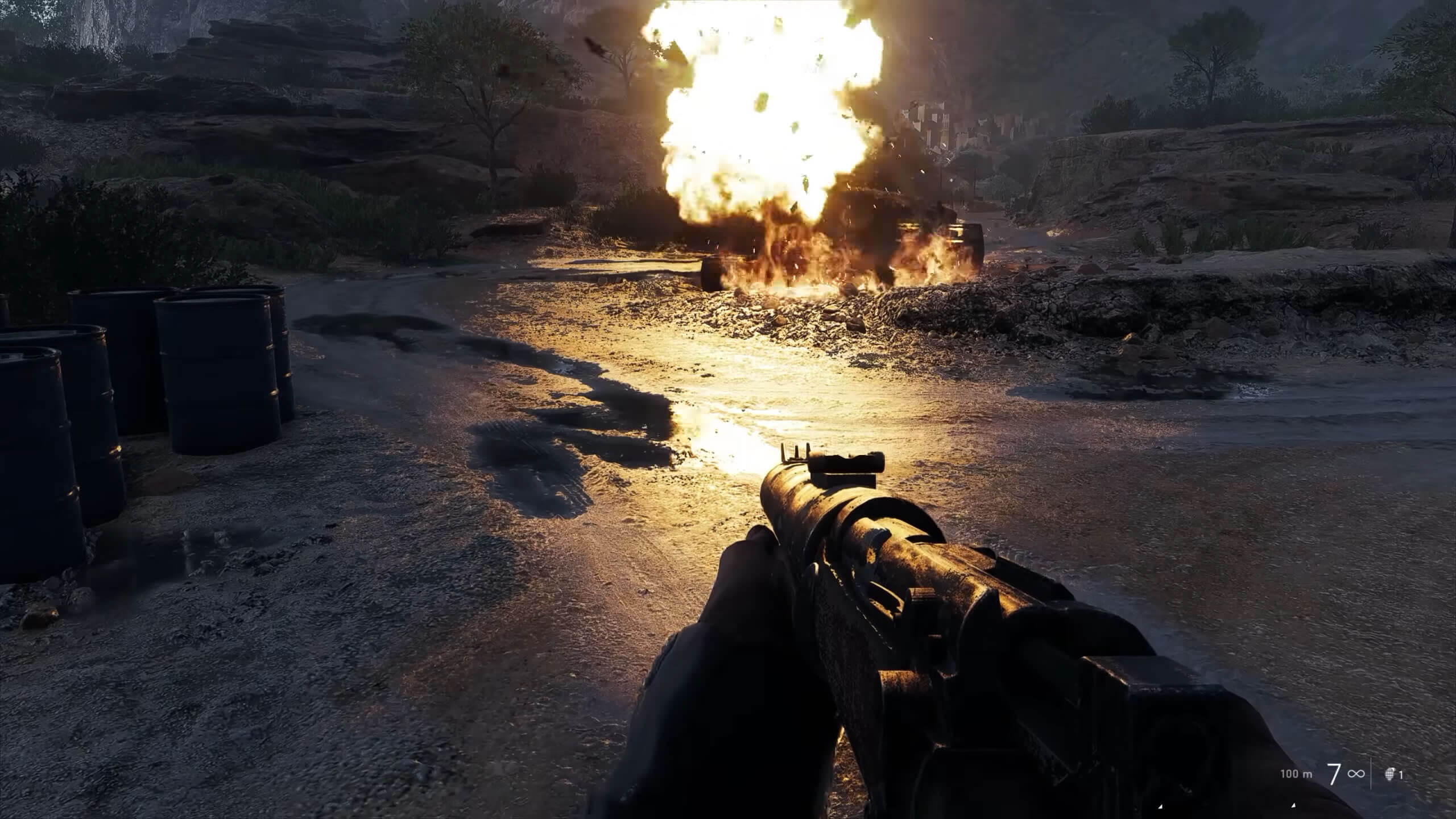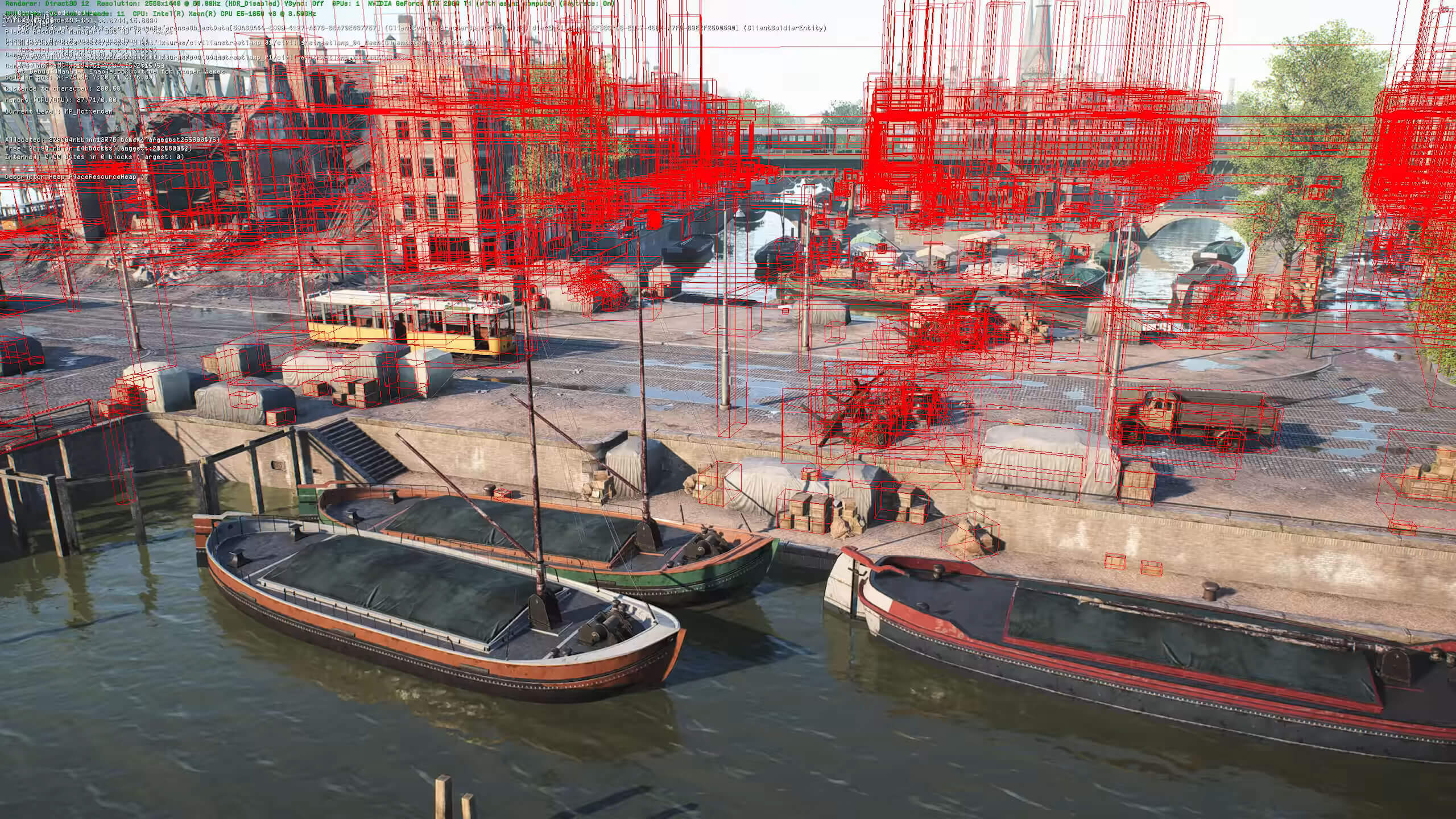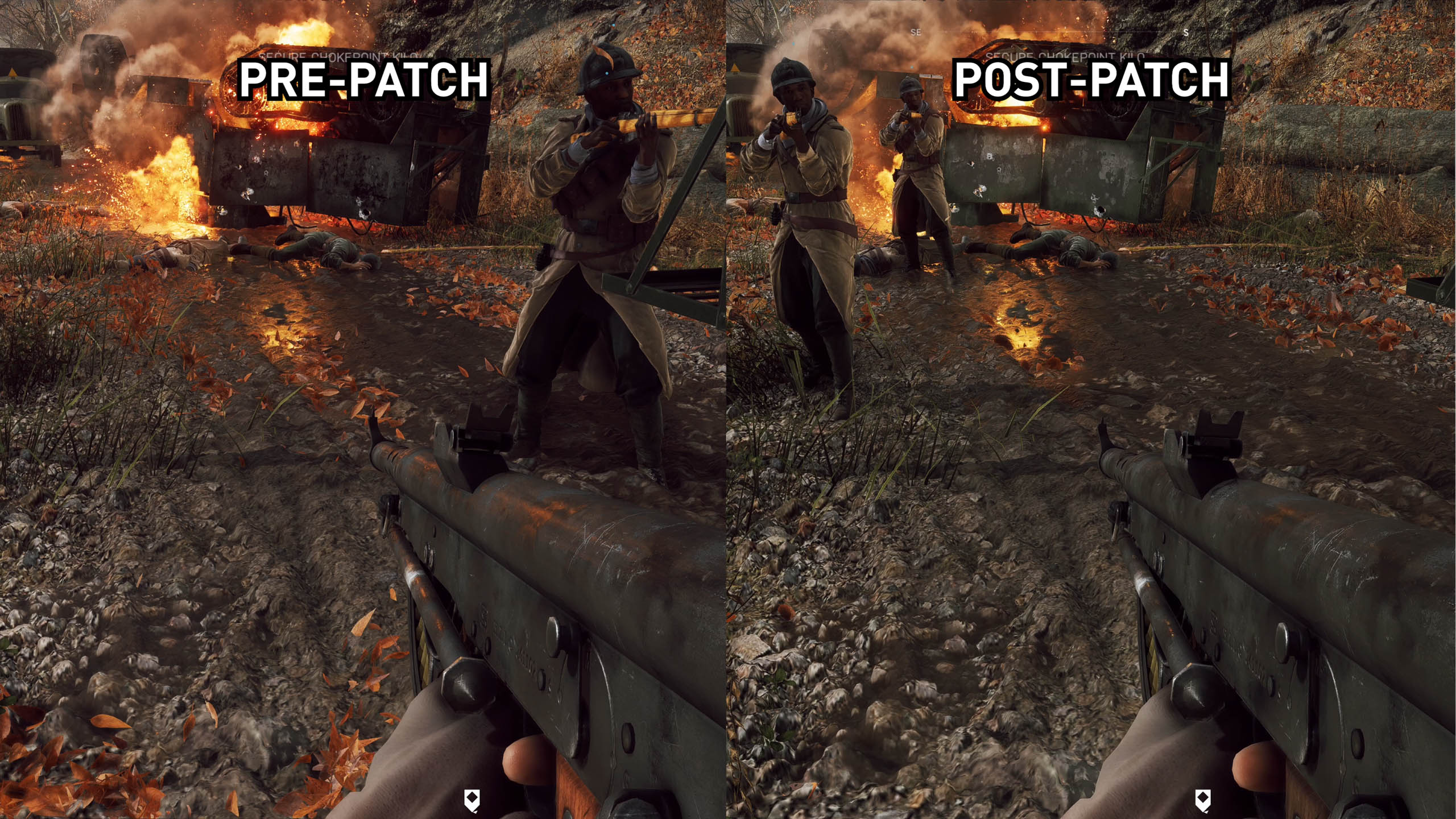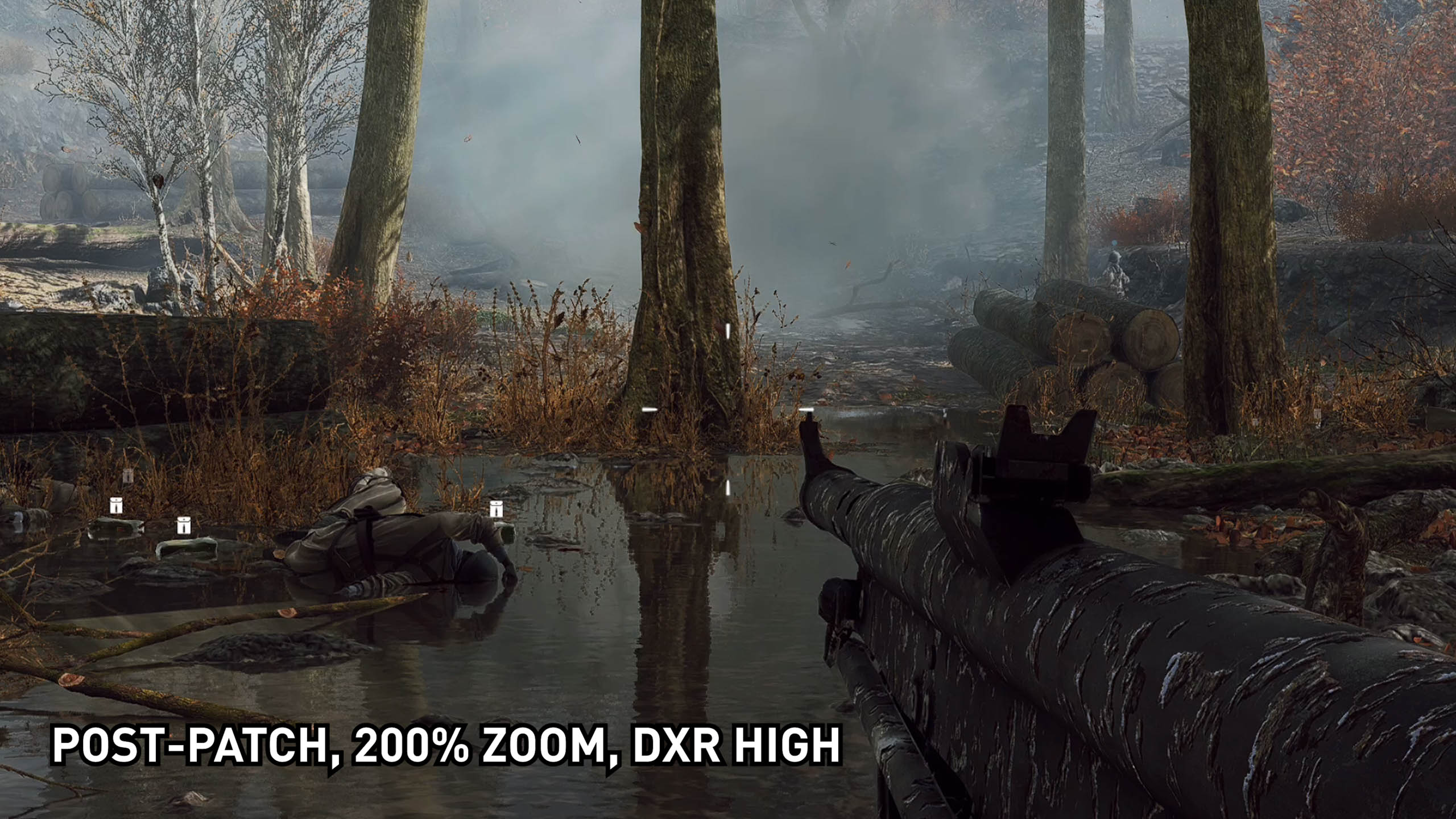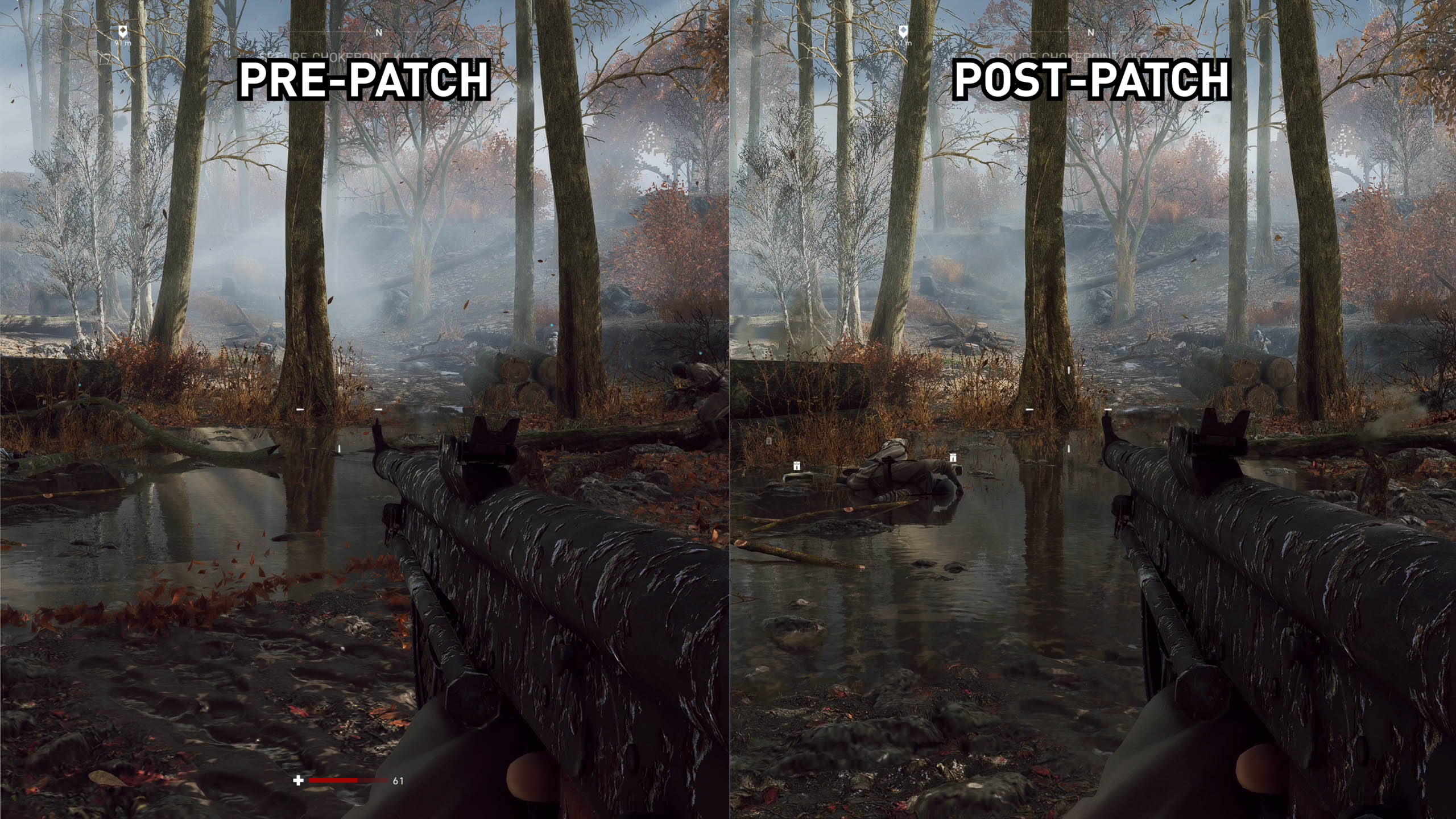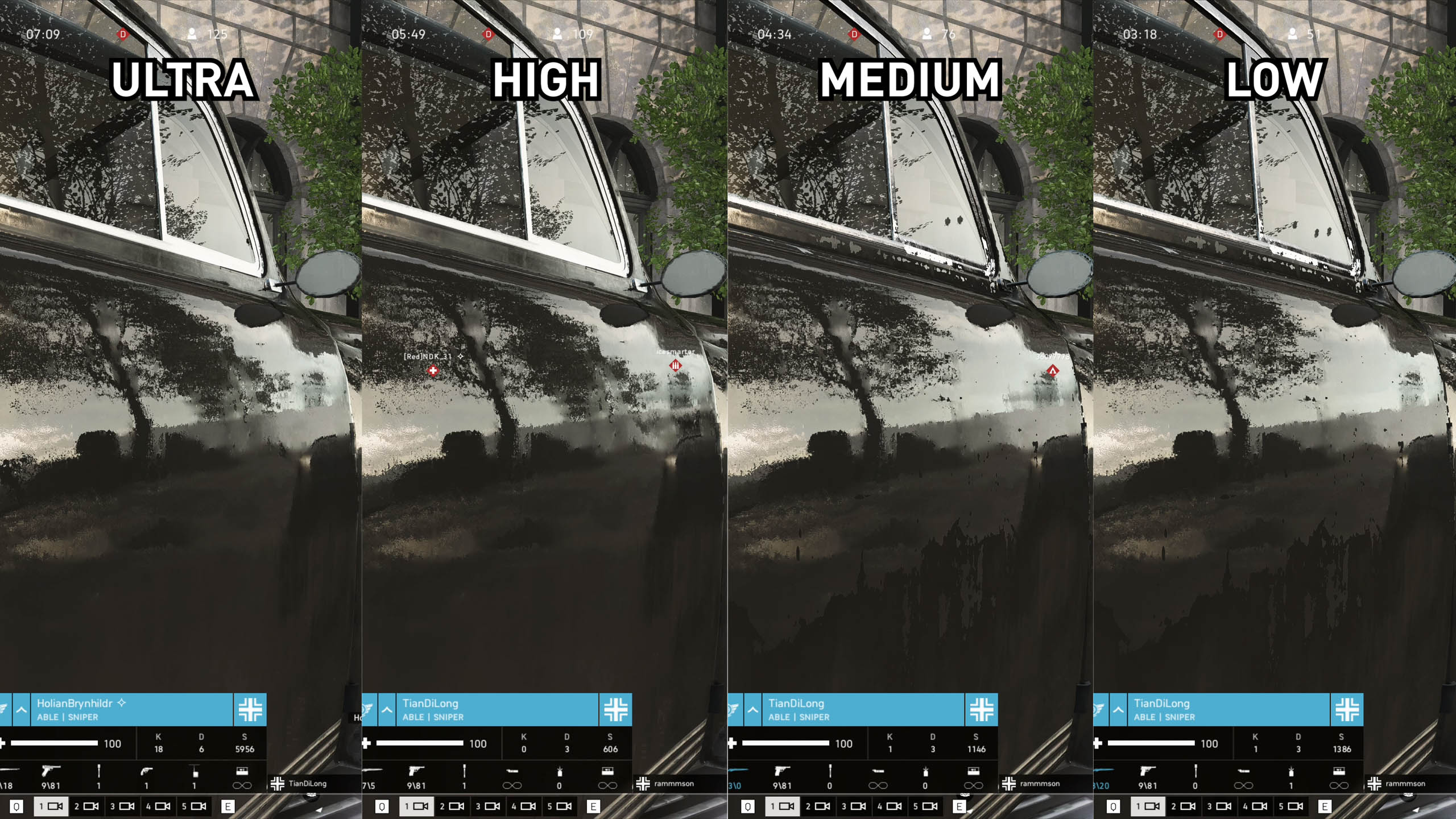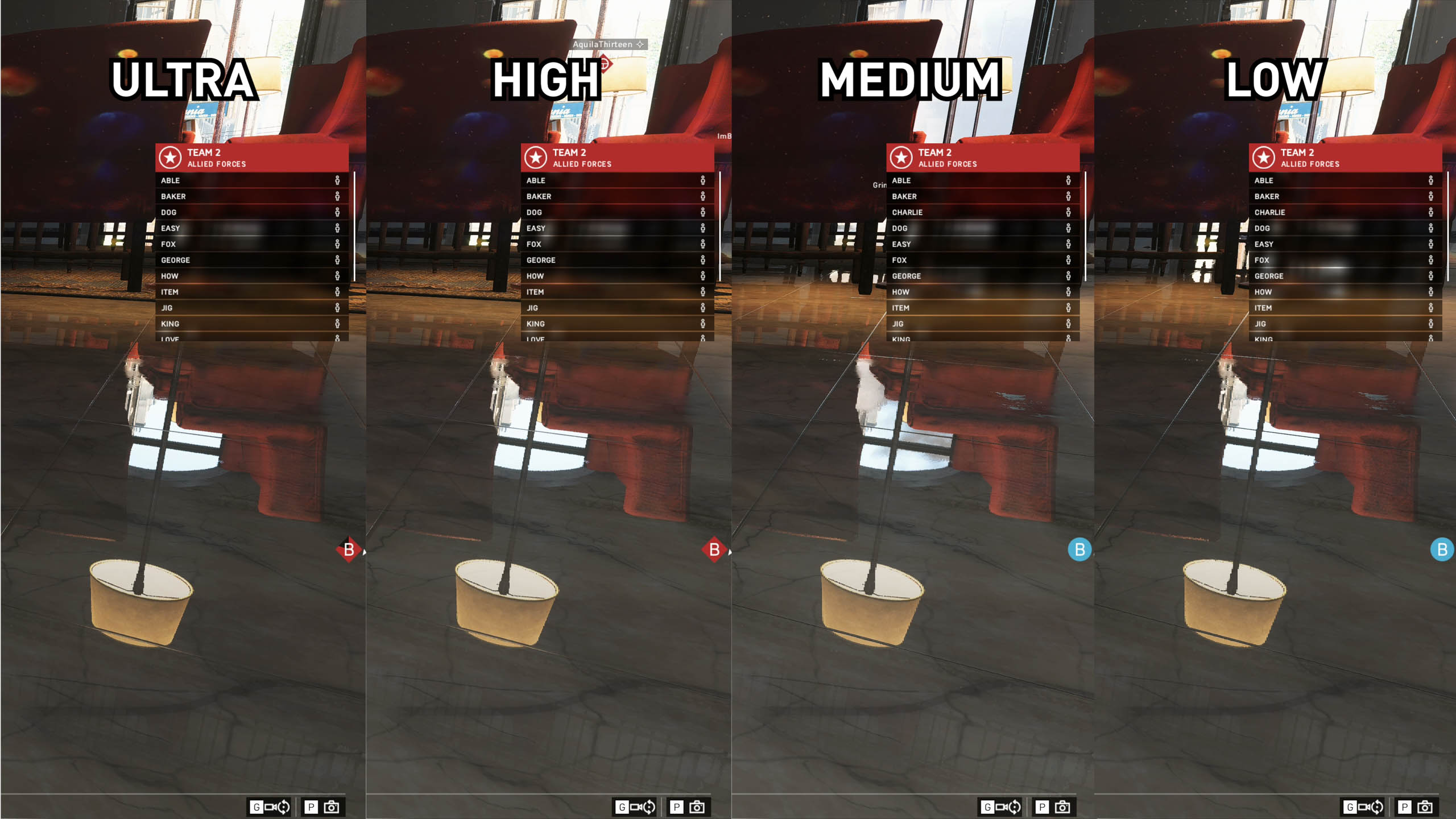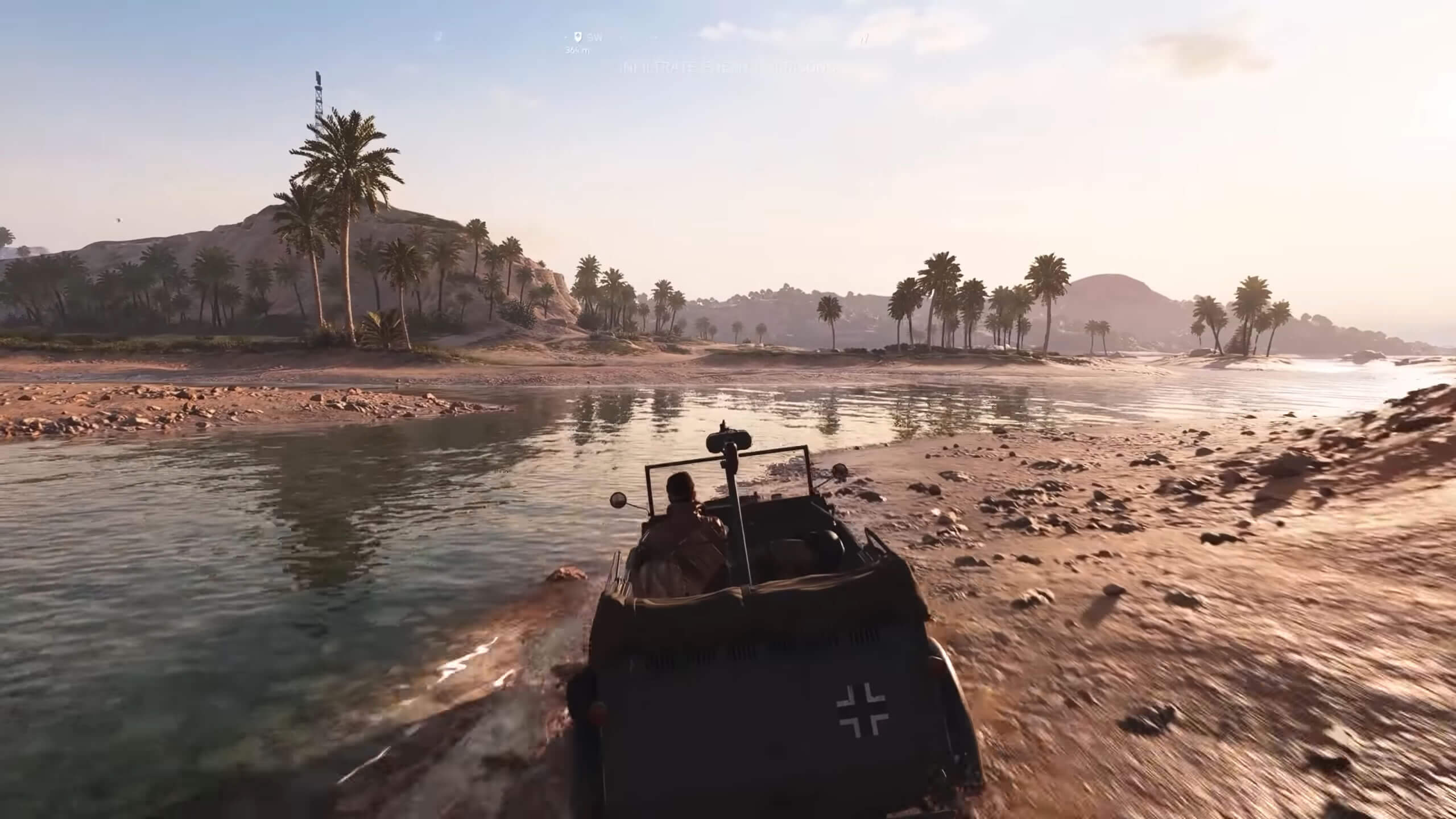After a less than encouraging debut of real-time ray tracing in Battlefield V, Nvidia and DICE have been working together to optimize the game's implementation of DXR. The improvements come in the form of new graphics drivers and a game patch, which collectively Nvidia claims can improve performance as much as 50%.
As you all know by now, after much anticipation ray tracing in Battlefield V was a bit of a disaster at launch. The implementation was plagued by technical issues including poor reflection resolution, things being incorrectly reflected, and loads of noise. On top of this, enabling ray tracing on even the lowest settings cut the game's frame rate in half or even into a third depending on the GPU and resolution at hand. This made the RTX 2080 Ti the only card suitable for ray tracing, and that was using the Low setting at 1080p.
However, with the update Nvidia says RTX 2080 Ti owners will be able to enjoy ray tracing at 1440p 60 FPS on Ultra, RTX 2080 owners should be able to do 1440p 60 FPS on Medium, and RTX 2070 owners are set for 1080p 60 FPS using Medium. Going on our past results, that does seem around the ~50% improvement they are claiming, and of course, we are running our own tests for verification.
However, the big question still lingers: how did DICE and Nvidia improve performance, and specifically, did they downgrade visual quality to achieve this? Nvidia has documented some of these into a video explaining the changes (watch above). I'm not going to list all of them here, but some of the biggest ones include optimizing variable rate ray tracing, adjusting the denoiser, and fixing ray traced foliage.
Variable rate ray tracing is the major change, this allows DICE to prioritize ray tracing on areas of the game world that will benefit the most from the effect, such as reflective or shiny surfaces. Essentially the game increases the quality of ray tracing on these surfaces, at the expense of a lower quality effect in other areas.
Considering many surfaces really don't need ray tracing at all, this has the potential to speed everything up. The foliage system was also a big performance hog, with DICE claiming a bug caused too many rays to be cast from foliage elements. That's now been fixed as well.
Visual Quality Impressions
So we're going to run some visual quality comparisons first to see if anything has changed, starting with some of the areas we tested last time. When looking at the Ultra DXR setting in the previous version compared to the latest patch, we observe no visual difference at all. It seems one of the areas DICE hasn't been able to improve is the quality of reflections on more matte surfaces like the gun, there's still a bit of pixelation to the effect there.
The same can be said about the Low setting: no real difference. In this scene, we don't notice any significant difference in visual quality between Low and Medium, or between High and Ultra, though you can spot that the higher two settings produce ray traced reflections on more surfaces, just like last time.
In this scene that features a large water puddle, again there's not a large difference between all four DXR modes, and some of the issues with godrays being incorrectly reflected still appear to be present.
However there is a visual quality downgrade that I spotted in this area, this new patch has introduced some artifacting to the way ray traced reflections are handled. Previously, everything that was supposed to be reflected, was reflected, so you got these nice, clean and for the most part supremely accurate reflections that blew away screen space reflections for visual quality. However with the latest patch, some screen space reflection-like artifacts have crept back into ray traced surfaces.
If you look closely at the water surface, at times an object will move across the reflected area like an AI character or a falling leaf, and for a brief moment you'll spot the classic screen space reflection-like streak caused by that object obstructing the reflection's path. My guess here is that DICE have chosen to more aggressively cull rays from objects not in view, which has improved performance significantly, but it's at the cost of the occasional artifact where something that should still be in view is getting culled erroneously. It makes the reflections slightly more ugly but it's still a significant upgrade on basic screen space reflections where this issue is much more widespread.
The other change seems to be a widespread modification to the particle system which makes leaves less likely to float over or land on reflected surfaces. I wasn't 100% sure, but I've looked in a variety of scenes and noticed that while the same number of particles are visible in the air and on matte surfaces in general, leaves just don't obscure puddles of water as often as they used to, and this is the case whether DXR is on or off. I even spotted some leaves landing on puddles randomly but then quickly disappearing.
This change does affect how the game looks without ray tracing enabled but I actually think it's positive overall, because particles caused lots of artifacts in screen space reflections as well, so toning down one area of that effect is good. And I'm not sure you would have noticed this if I didn't point it out.
As for noise, there is still a fair bit of noise to DXR reflections depending on the surface, in particular it seems that DICE haven't been able to solve the extreme noise present on larger water surfaces. The rippling waves are just too much for the denoiser to handle and what you're left with is a ton of ugly noise.
However, noise has been improved for cleaner surfaces like windows. Gamers Nexus showed in their video this tram car window that had a ton of noise in its reflection when you move around. With the latest patch you can still spot noise when moving about, but the denoiser is much faster to respond, so there's less 'noise ghosting' in the image. In other areas you might spot noise only for reflected trees, while static objects remain nice and sharp. Again, I suspect the issue with foliage noise is down to some of the changes they've made to improve performance with ray tracing foliage.
In our previous benchmark feature we had a hard time spotting the difference between the four DXR modes and came to the conclusion that there were really only two modes. But looking more closely there does appear to be subtle differences between the four modes in terms of reflection resolution and draw distance. The higher the setting, the cleaner the reflections will look and the more draw distance you'll get. It's all very subtle though, which leaves Medium looking almost identical to Low for the most part, and similarly, High looks very close to Ultra.
Overall we'd say the patch has, for the most part, resulted in no change to DXR visual quality, though adjustments have clearly been made. Most of the work seems to be focused on making sure ray tracing isn't unnecessarily applied, and that's where the performance improvements have come from, though there are still some notable areas that need further work like reflection noise.
Benchmarks
So let's talk performance. The first thing to note is that to get improved DXR performance you need both the latest Battlefield V patch and Nvidia's new GeForce 417.22 driver. The driver alone seems to provide ~ 6 to 8% improvement to ray tracing performance with the pre-patch version of the game, so Nvidia definitely has done some driver side work to improve DXR performance. We noticed this in some preliminary testing, however we then applied the game patch which improved performance further and this is the new performance measurement we're reporting. The new driver did not impact "RTX off" performance, which is identical to our first DXR test.
Our testing is much more comprehensive this time around, too. We've tested the RTX 2080 Ti, RTX 2080 and RTX 2070 at 1080p and 1440p on our Core i7-8700K test rig overclocked to 5.0 GHz. Post patch, we've tested all four DXR presets, so you can see how the performance differences stack up. We've also tested two areas instead of just one: the first is the Tirailleur area we used in our initial article, which is a bit of a ray tracing stress test and showed the worst performance in the game. But we've also included performance in the Nordlys area, which is a snowy map that has virtually no ray tracing and honestly, looks very similar whether you have DXR on or off.
First up we're going to look at RTX 2080 Ti performance in the intensive Tirailleur map at 1080p. We're looking at a 57% improvement to average frame rates for the Ultra DXR mode, and a 21% improvement for the Low mode. Despite a small reduction to frame rate for DXR off, this mode is still 75% faster than Ultra DXR, and 53% faster than Low DXR. Previously there was more than a 2x difference, but this performance penalty is still pretty brutal.
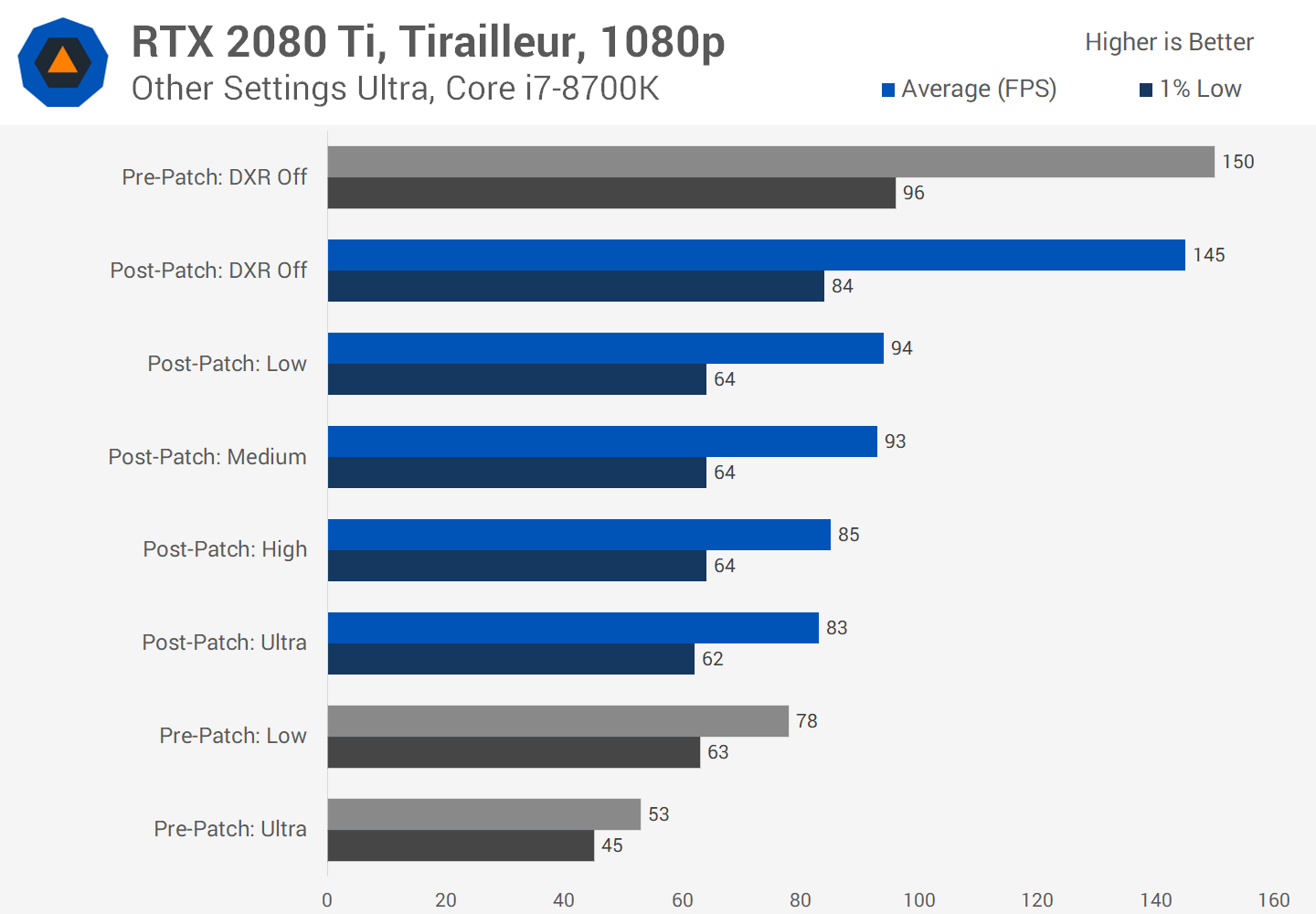
At 1440p it's a similar story: a 51% improvement to Ultra performance, and a 29% improvement to Low performance. "DXR off" is more than twice as fast as Ultra, while there's a 53% advantage over Low.
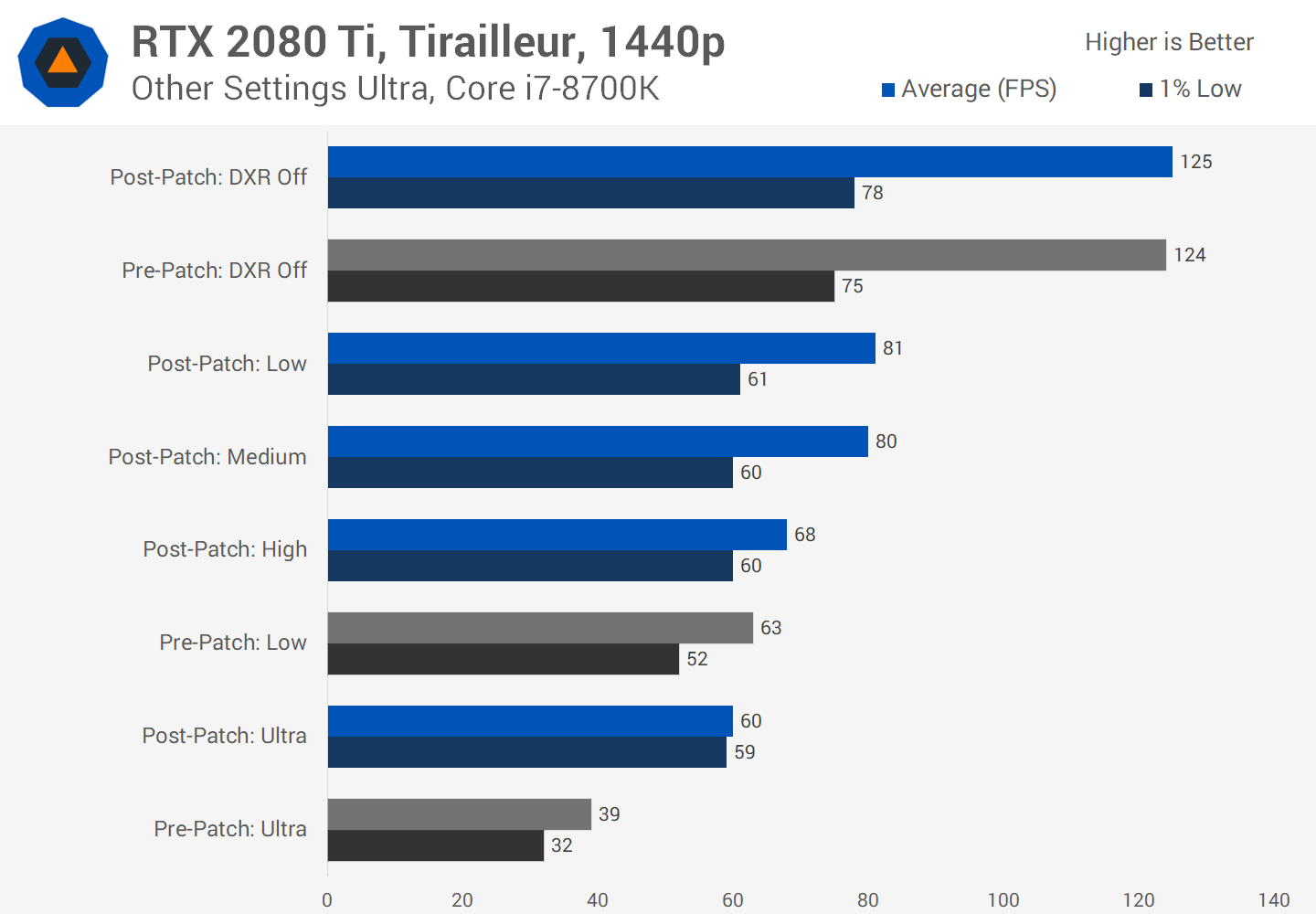
Unfortunately the situation is worse in the Nordlys map. Yes, there's a performance improvement at 1080p, but Ultra is only 18% faster and Low is just 5% faster comparing the pre and post patch performance. On top of this, DXR off is still 56% faster than DXR Low and in our test area there is essentially no visual difference between the two modes. The game still needs to cast rays though, even if it has no effect on the visuals, which causes this massive drop to performance.
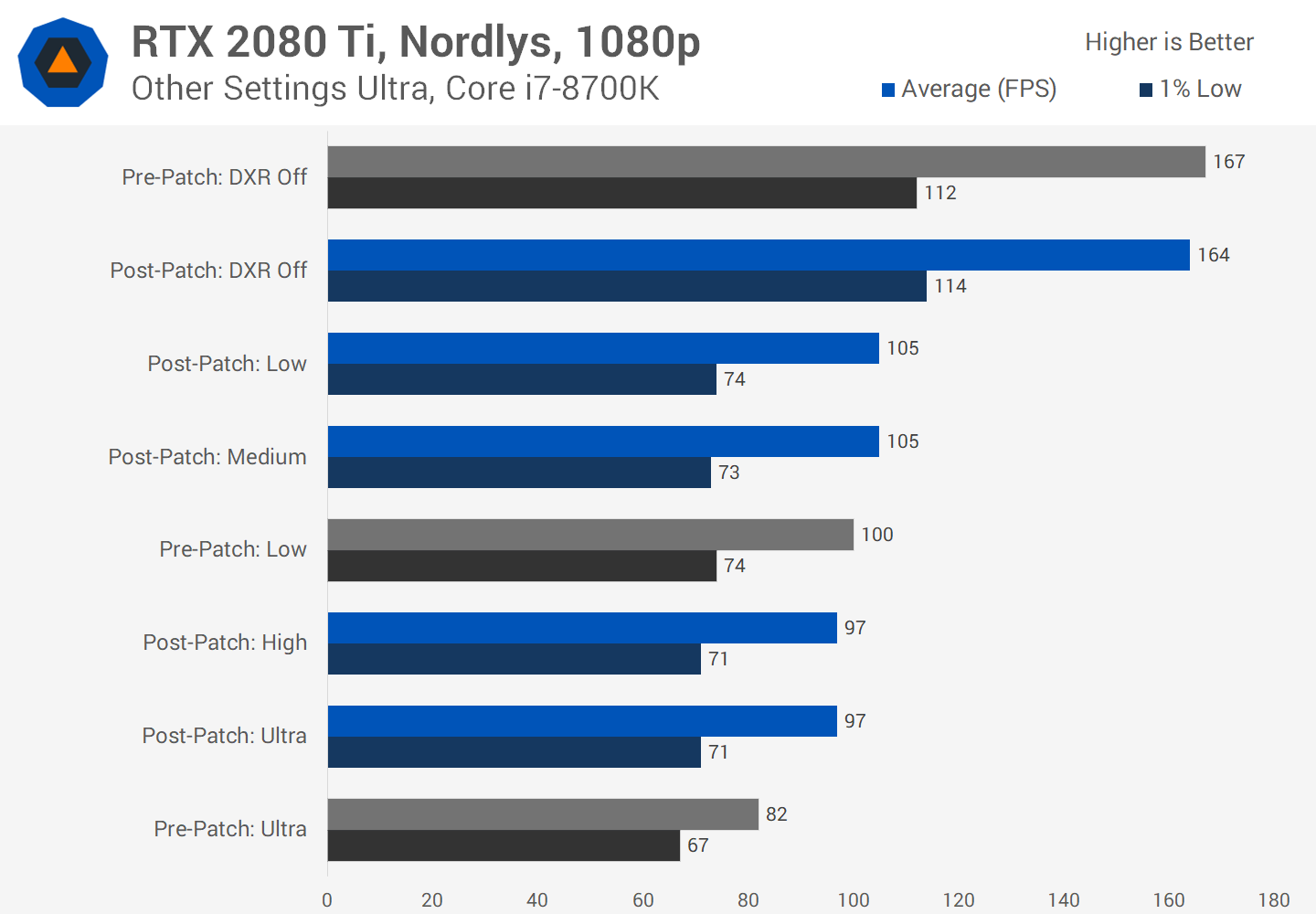
At 1440p, again, similar story: the performance improvement is slightly higher but DXR off is still much faster.
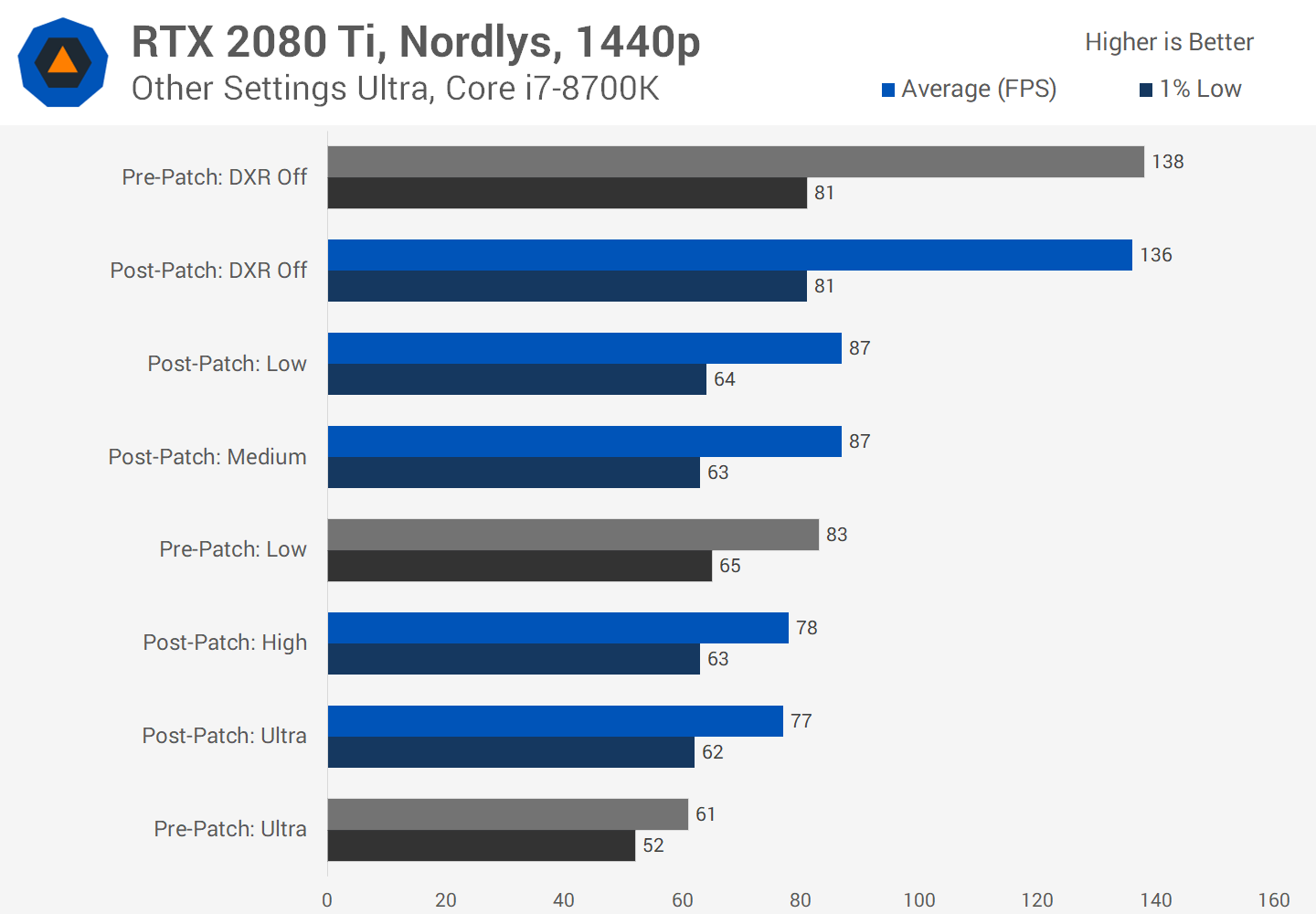
The good news when looking at these RTX 2080 Ti results is that Nvidia's claims about performance are correct: you can play using the Ultra DXR mode at 1440p and expect 60 FPS. You could also get 90 FPS using DXR Low at 1080p. But in both situations, turning off DXR delivers well over 100 FPS, so ray tracing remains a huge performance hog.
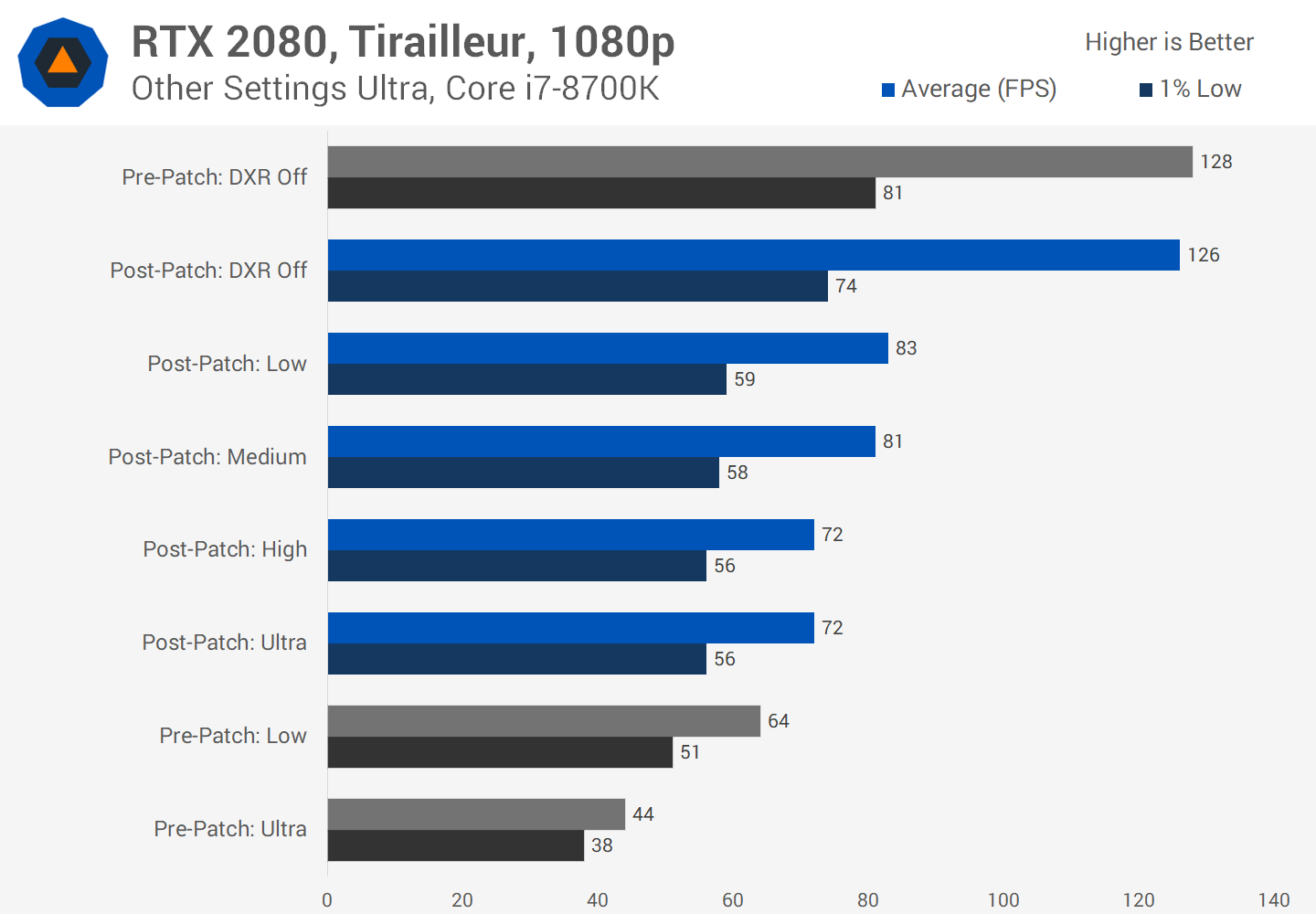
Time to look at the RTX 2080. In Tirailleur at 1080p the improvements for Ultra and Low were 64% and 30%, respectively, when compared to the game pre-patch. However the game is still more than 50% faster with DXR disabled, compared to DXR Low.
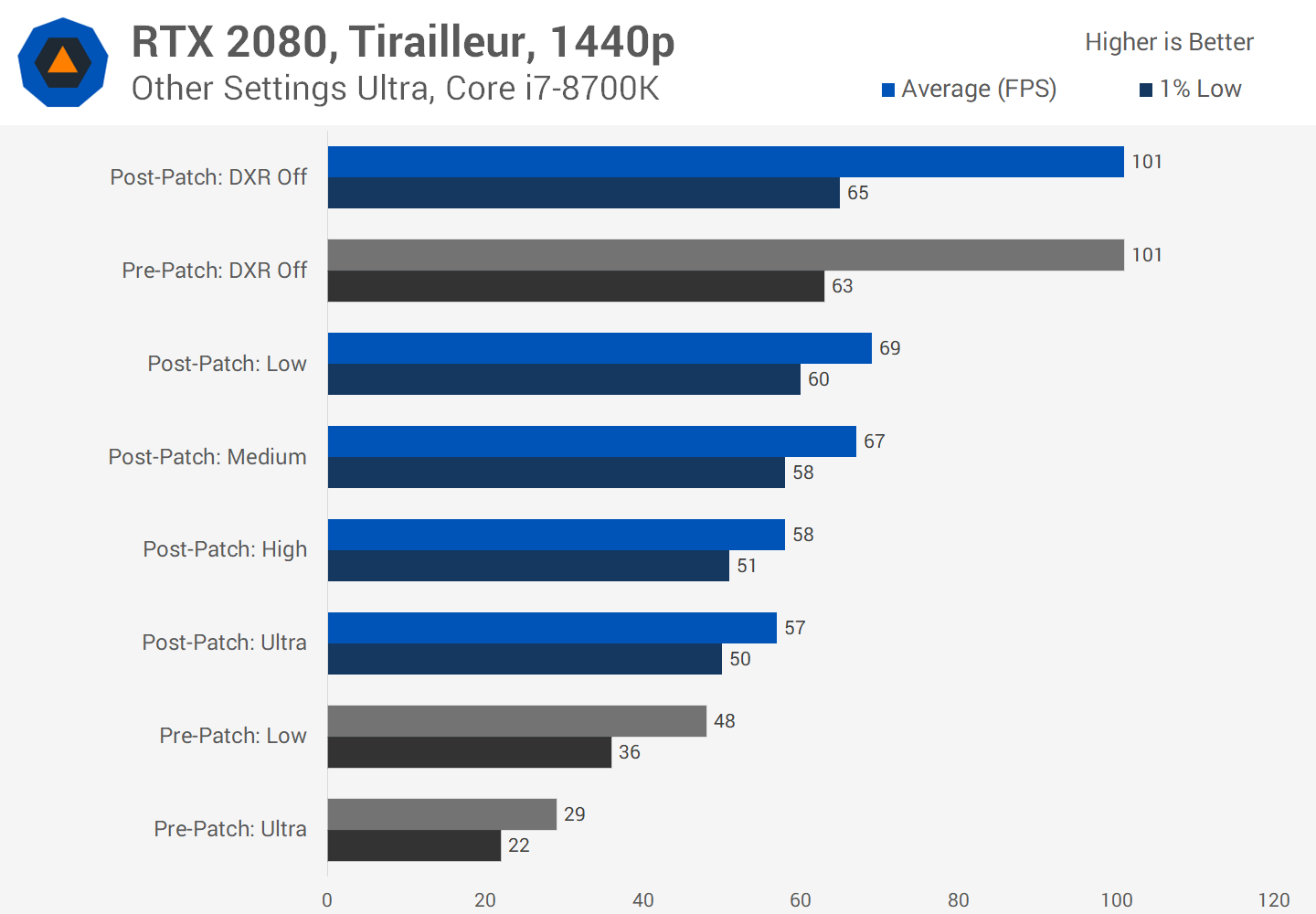
At 1440p Nvidia is correct in saying the RTX 2080 can deliver a 60 FPS experience using the Medium DXR mode. Performance improvements are similar to what we've already been discussing but again, performance is more than 50% faster with DXR Off.
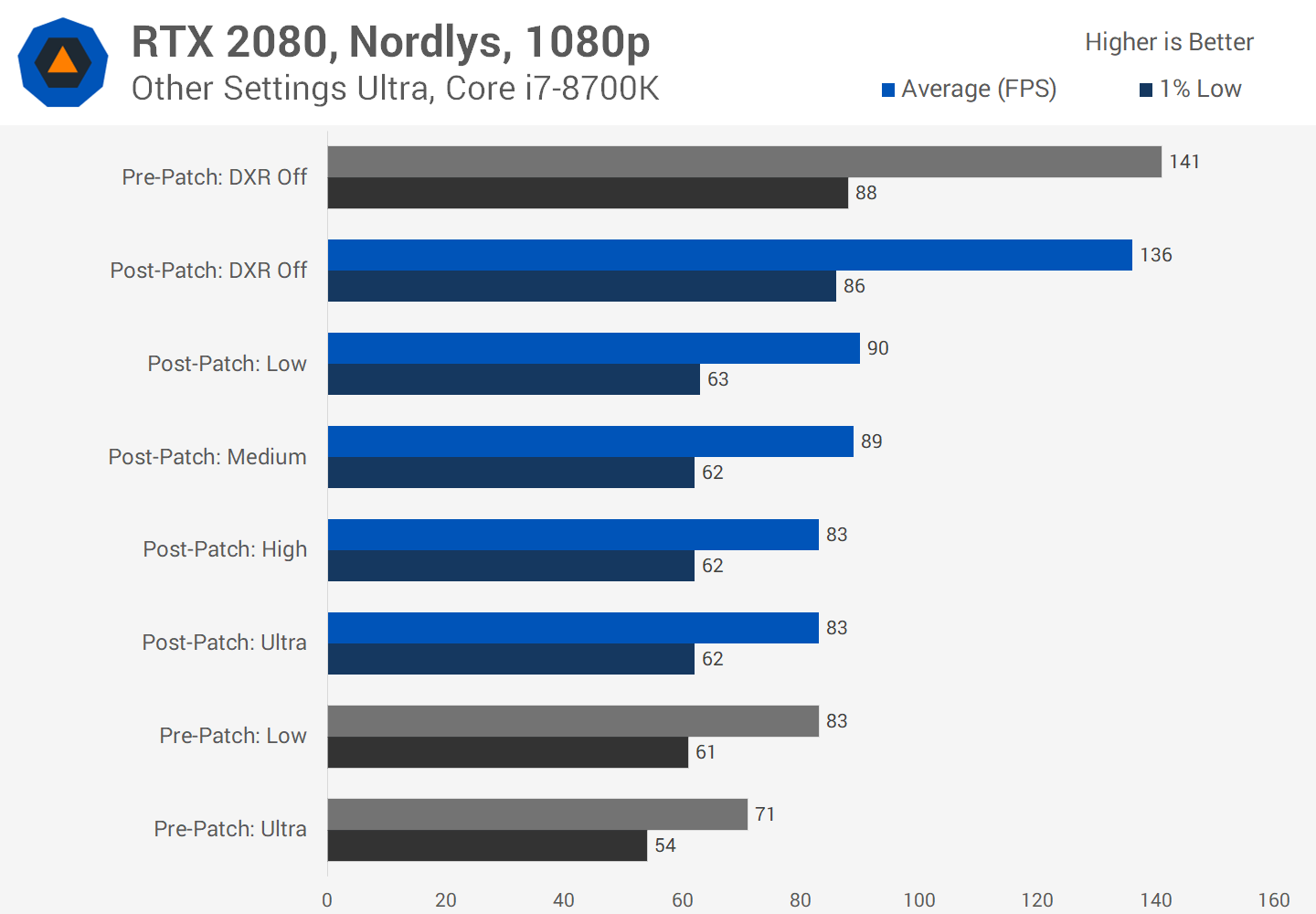
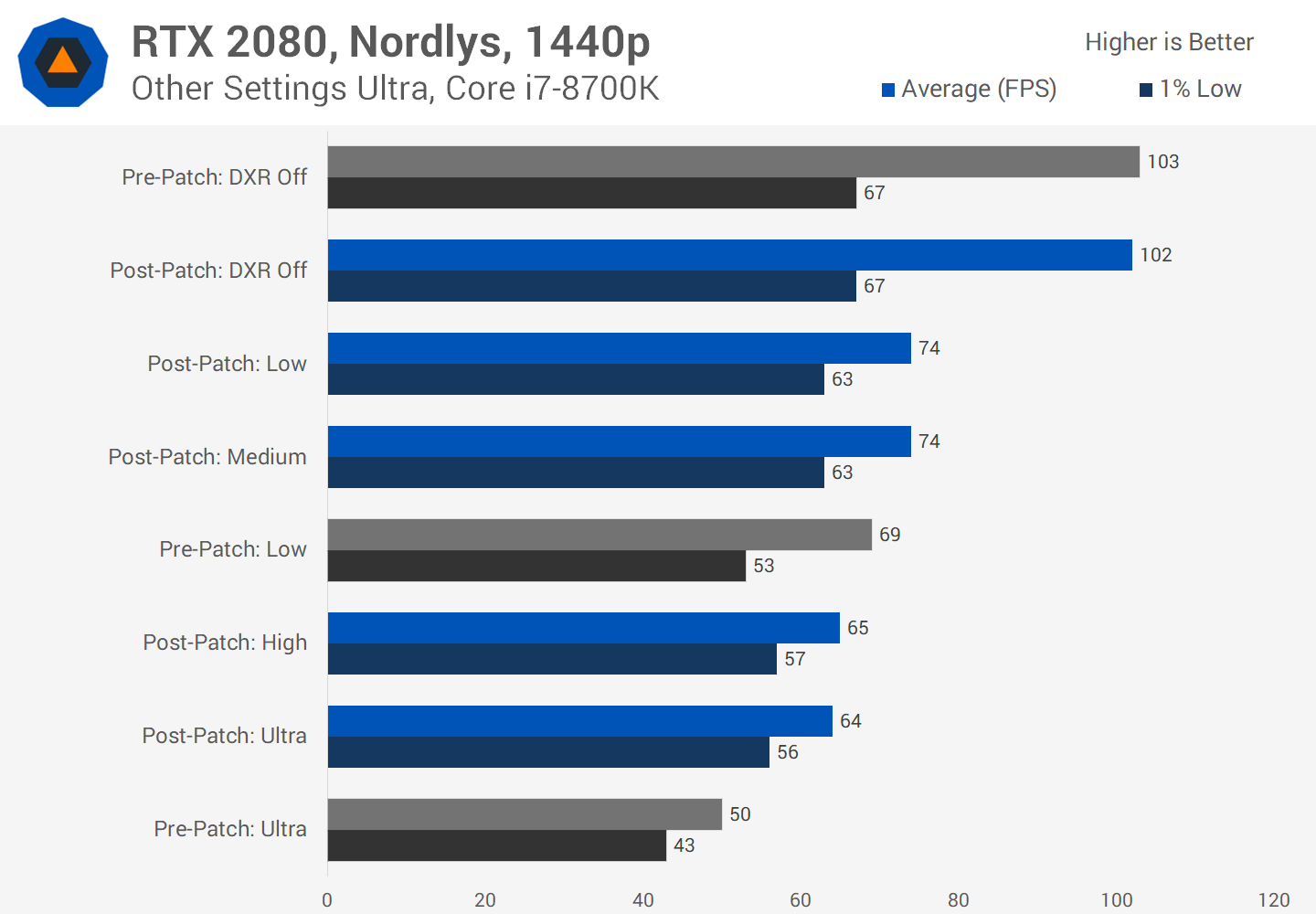
In the less intensive Nordlys at 1080p, gains are modest like with the RTX 2080 Ti at below 20% for both the Ultra and Low modes. And once again, in what's a repeating theme here, performance is improved by more than 50% with the effect disabled. It's a similar story at 1440p as well in this map.
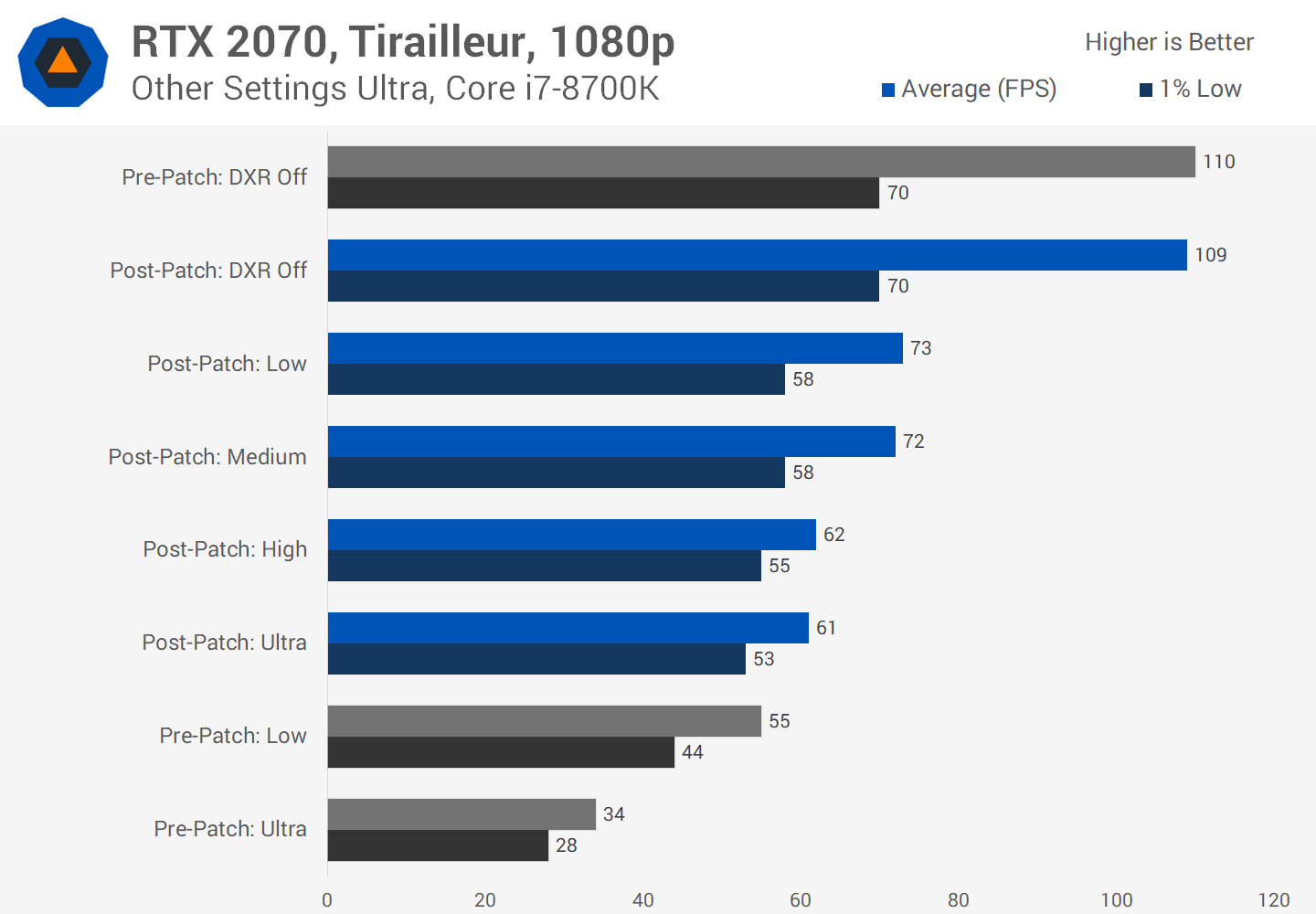
The RTX 2070 is a GPU we called useless for ray tracing last time because it couldn't even achieve 60 FPS at 1080p with the Low DXR mode. Post-patch in the Tirailleur area, we're looking at gains of 79% using the Ultra mode, and 33% for the Low mode. That makes the Low mode suitable for 1080p 60 FPS as Nvidia states. However, yes you guessed it, performance is ~50% higher with DXR disabled compared to on the Low mode.
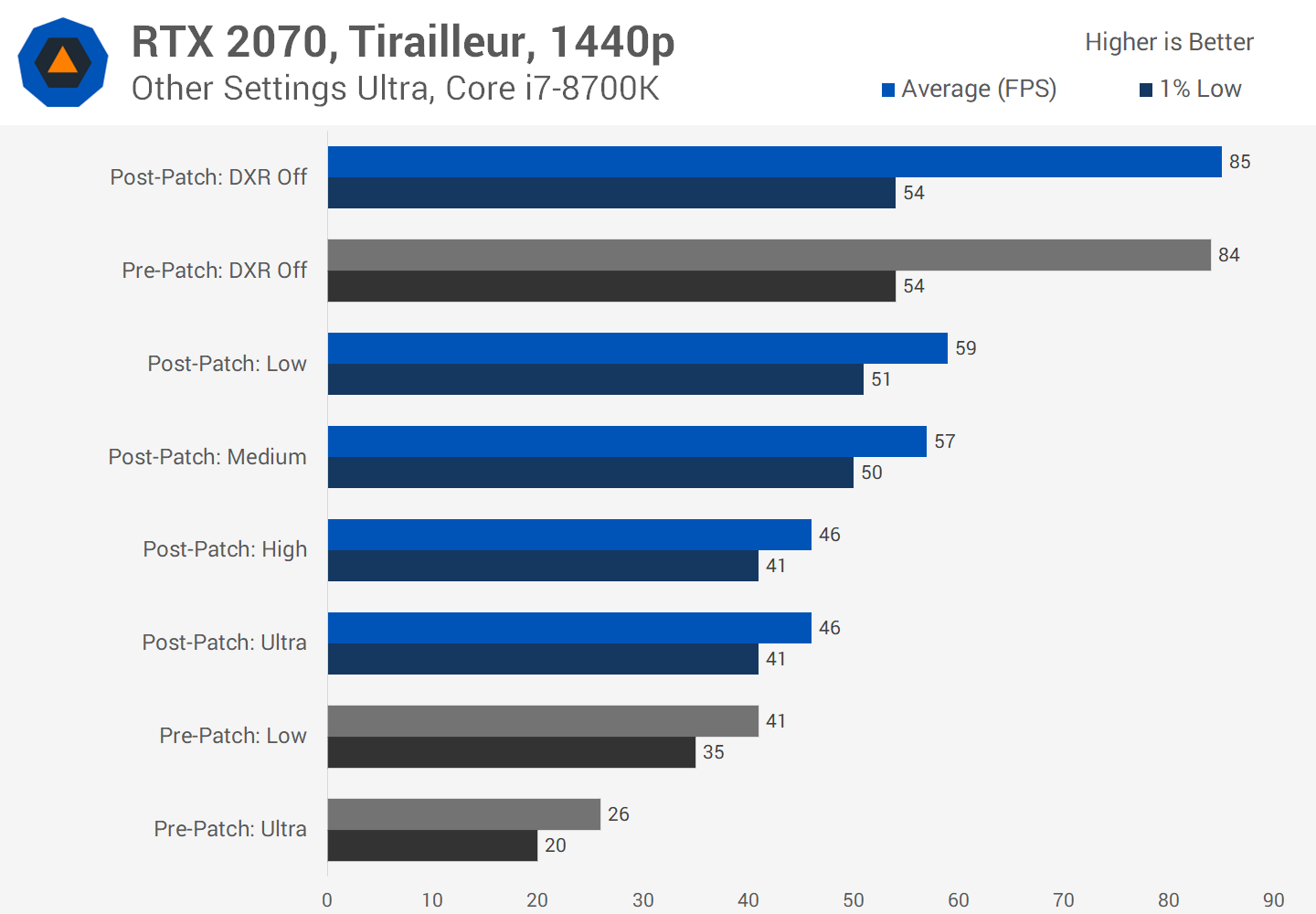
It's probably not worth talking about 1440p DXR with the RTX 2070 because the GPU struggles to reach 60 FPS with DXR on Low, though this is a big improvement over what we saw previously. Performance here is around 42% higher with DXR disabled.
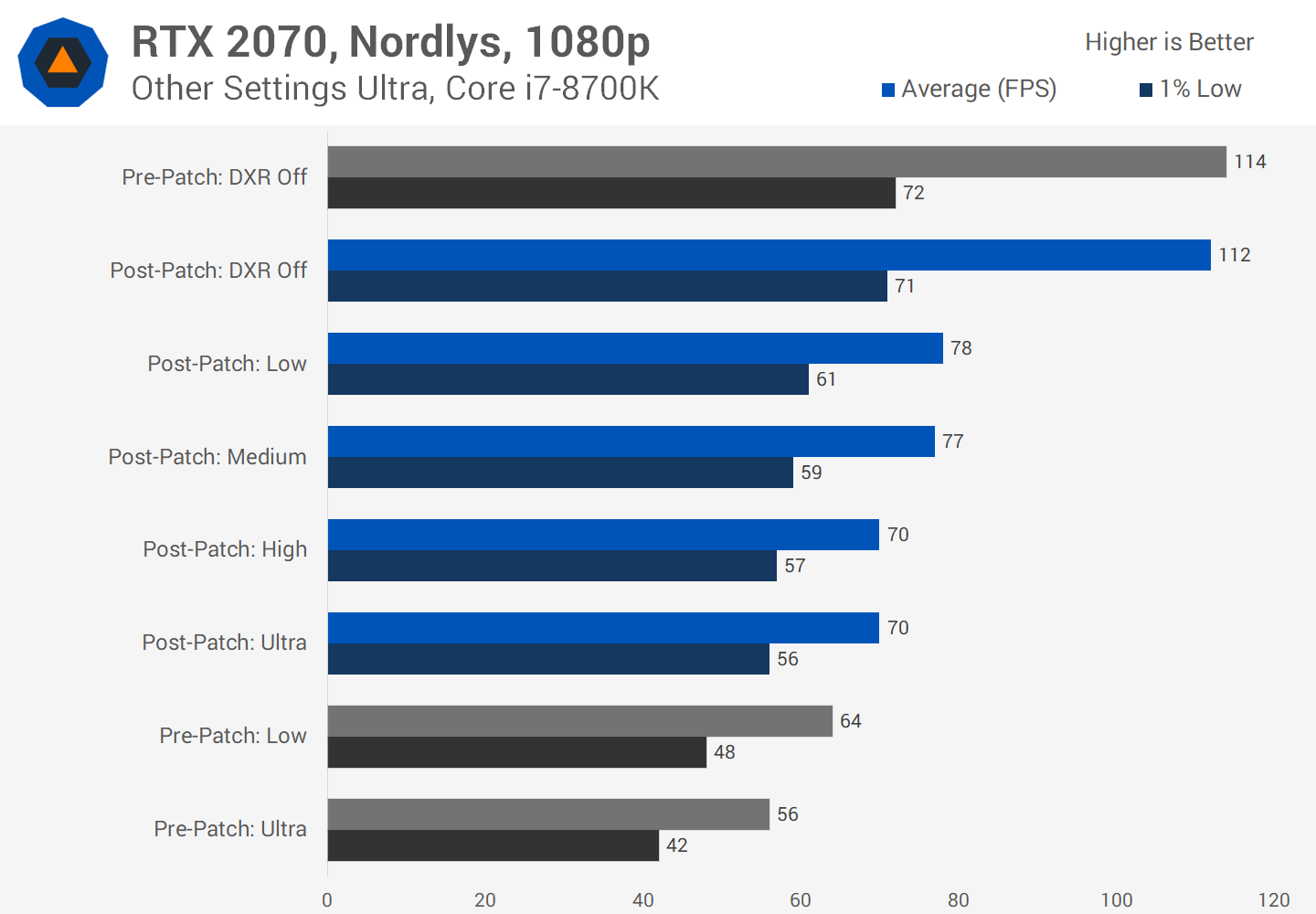
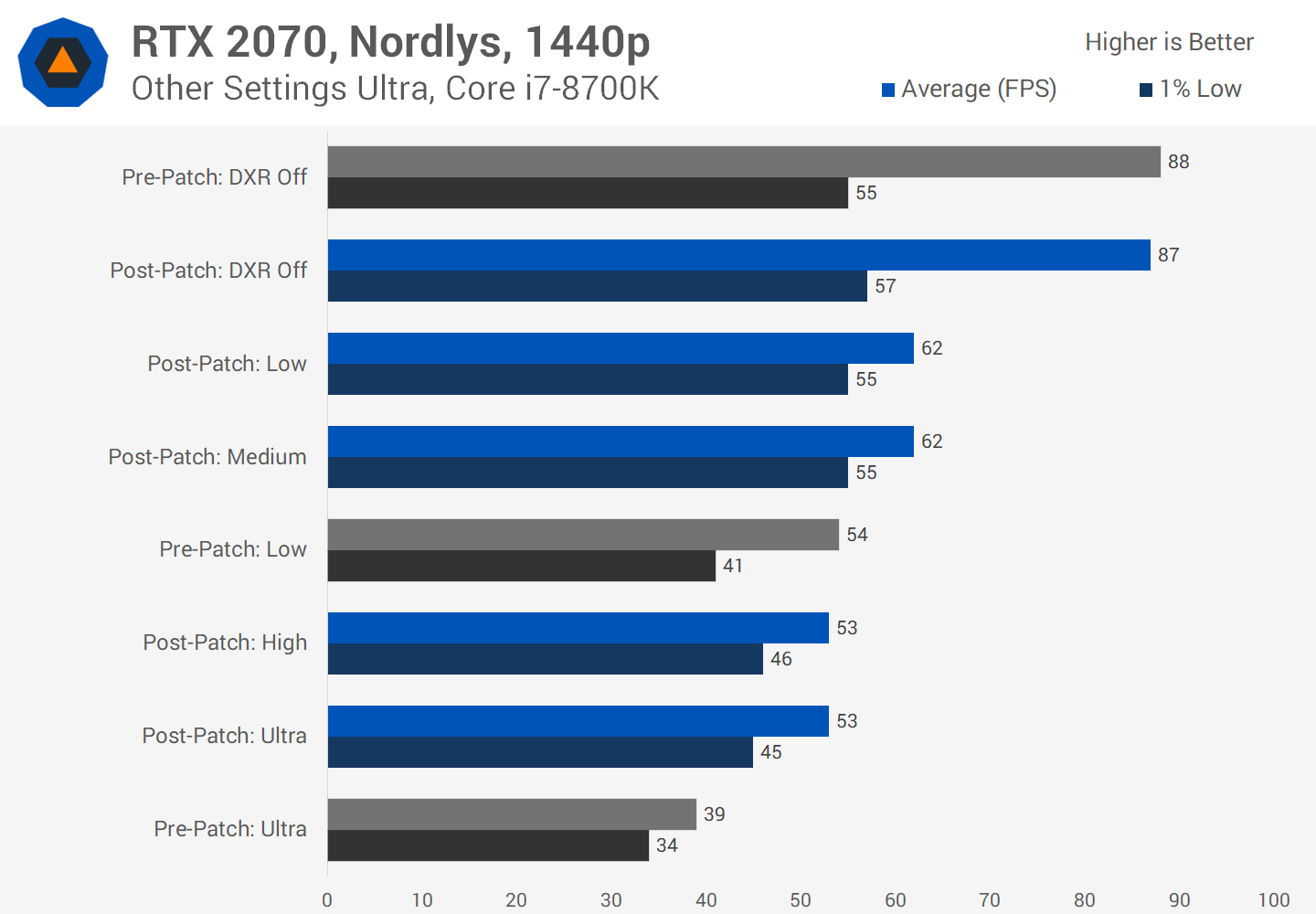
And finally we have the Nordlys map, at 1080p we're seeing gains of 22% comparing the Low mode before and after the patch, while Ultra gets a 25% boost.
Ray Tracing: Take Two
Nvidia is right on the money with their performance claims: a 50% uplift to ray tracing performance in patched Battlefield V is real, and what they say is possible with their various RTX GPUs is indeed possible, and in the more intensive areas of the game no less. We're now in a situation where the RTX 2080 Ti can use DXR Ultra at 1440p, the RTX 2080 is suitable for DXR Low at 1440p or Ultra at 1080p, and the RTX 2070 is now able to handle 1080p with DXR Low. That's significant, especially for the RTX 2070 which before was hopeless. But, there are a lot of caveats to those claims...
You'll only see 50% performance gains in the Ultra mode. Gains are less significant in the Low mode, closer to the 30% mark. And these improvements are only in areas where there are lots of DXR reflection effects. In areas where there are no visible reflections, you'll see more modest performance gains of 25% or lower.
... a 50% uplift to ray tracing performance in patched Battlefield V is real (but...)
And this is where the problems continue to exist for ray tracing in Battlefield V. In the Nordlys area we tested, and other areas with few DXR effects, the patch doesn't improve performance considerably. That's a big deal because we're still in a position where turning DXR off provides 50+% more performance for practically identical visuals. Thus, having DXR enabled in these areas is just wasting processing power, reducing frame rates from ~130 FPS down to ~80 FPS for zero visual improvement.
In other game areas where ray tracing is visually appealing, the performance difference between DXR on and off is still enormous. In a best case scenario you're looking at 50% more performance with DXR off, but if you use the High or Ultra modes for the same comparison, that gap grows to over a 2x performance boost depending on your GPU and resolution.
... the discussion now becomes whether ray tracing will be worth having in other games.
In general we still don't think Battlefield V is a suitable game for ray tracing. As a technology showcase, sure, but for actual gameplay, this is a fast paced shooter that you want to run at high frame rates. Why would someone with, say, an RTX 2070 choose to play at 1080p 60 FPS with DXR low, compared to 1440p 80 FPS with DXR off? Why would an RTX 2080 Ti owner lock themselves into 1440p 60 FPS when you could run the game at 4K with higher frame rates, or at 120+ FPS at 1440p? It's not a sensible choice for this sort of game.
And if you're playing multiplayer, it's almost impossible to tell whether DXR is on or off. We've shown a lot of static comparisons, nice slow close ups and that sort of thing here, but the reality is when playing the game you're not stopping to look at the nice reflections, you're focused on enemies and objectives. In fact, for the multiplayer modes we not only recommend disabling DXR, but turning down other quality settings as well for maximum performance.
With that into consideration, the discussion now becomes whether ray tracing will be worth having in other games, say for example in single player titles like Shadow of the Tomb Raider where you have more time to appreciate the visuals. While Nvidia and DICE have clearly worked hard to improve ray tracing performance in Battlefield V, and we're no longer left with half to a third of the performance as a baseline, the performance hit is still going to be brutal in other games.
If in the very best case scenarios you can increase your frame rate by 50% when disabling DXR reflections, I hate to think what the performance hit will be when games integrate other DXR effects. Shadow of the Tomb Raider, for example, was set to use DXR lighting and shadows, which is only going to tank performance further. And what if a game doesn't use the optimizations DICE has achieved in Battlefield V? We could see more performance losses again. And this is without considering the noise and other issues with ray tracing at the moment.
We genuinely hope Nvidia can continue to work on and optimize ray tracing to get more performance at no cost to visuals, because at the moment the technology still isn't ready, not for gaming. We salute their efforts and we understand this is a first generation GPU to integrate such a complex rendering technique. But in terms of what you're going to buy tomorrow, ray tracing cannot be a key selling point for Nvidia's RTX cards, a luxury bonus sure, but not something you should base a purchasing decision on.
